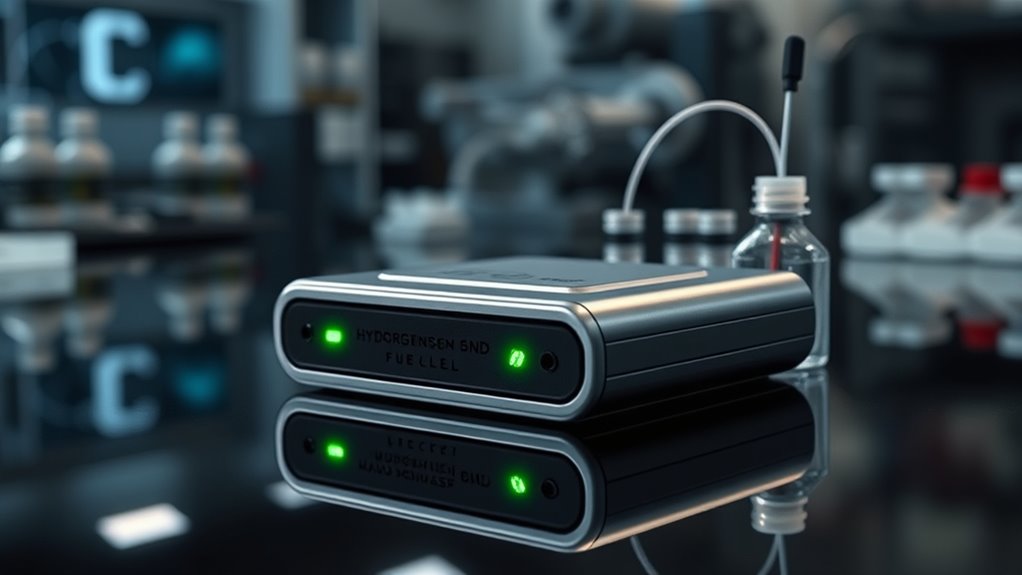Hydrogen-on-demand fuel cells offer a safe, compact power solution for portable use by generating hydrogen only when you need it. They rely on chemical reactions with fuels like sodium borohydride or natural gas, removing the need for bulky tanks and reducing safety risks. These systems deliver on-site hydrogen, powering fuel cells that produce electricity, water, and heat efficiently. To discover how these innovative systems can boost your portable energy options, explore further below.
Key Takeaways
- Hydrogen‑on‑demand fuel cells generate hydrogen only when needed, enhancing safety and reducing storage risks for portable applications.
- They utilize chemical reactions, such as sodium borohydride decomposition, to produce hydrogen directly at the point of use.
- The system’s compact design allows integration into portable devices, vehicles, and emergency power sources.
- On-demand hydrogen production eliminates bulky tanks and high-pressure storage, simplifying infrastructure and transportation.
- These fuel cells provide clean, efficient power with minimal safety concerns, ideal for mobile and remote environments.

Hydrogen‑On‑Demand Fuel Cells offer a versatile and safer alternative to traditional hydrogen storage, producing hydrogen only when needed through chemical reactions. This approach eliminates the need for bulky, high-pressure tanks and reduces safety risks associated with storing compressed hydrogen. Instead, these systems generate hydrogen on-site using chemical or fuel processing reactions, making them ideal for portable power applications. You can think of it as having a reliable, on-demand hydrogen supply that’s integrated into a compact system, perfect for scenarios where space, weight, and safety are critical.
Hydrogen‑On‑Demand Fuel Cells provide a safe, compact, and on-site hydrogen source for portable power solutions.
At the core of these systems is a fuel processor, which converts fuels like natural gas, biogas, or sodium borohydride into a hydrogen-rich gas with the right purity levels. When you need power, the fuel processor kicks in, releasing hydrogen through a controlled chemical reaction. For instance, sodium borohydride reacts chemically to produce hydrogen and inert salts, but this reaction is reversible, allowing the byproducts to be recycled back into fuel. This process guarantees you get pure hydrogen only when necessary, increasing efficiency and safety. Because hydrogen is generated on demand, there’s no need for large storage tanks, and the system can be scaled down or integrated into portable devices or vehicles.
Once hydrogen is produced, it’s supplied directly to the fuel cell stack, which uses electrochemical reactions to generate electricity. You’ll find that the fuel cell stack comprises proton exchange membrane (PEM) electrodes where hydrogen from the fuel processor reacts with oxygen from the air. This produces electricity, heat, and water—clean, efficient byproducts. The electrical output is usually in DC form, managed by a power electronics module that converts it into AC when needed. This setup allows you to power various devices or connect to electrical grids seamlessly. Control systems play a crucial role by regulating hydrogen delivery, air supply, and overall system operation, ensuring ideal performance and safety. Additionally, incorporating detoxifying juices into your lifestyle can promote better overall health and energy levels, supporting the demanding operation of such advanced systems.
Compared to traditional hydrogen storage, on-demand systems offer numerous advantages. They reduce the risks of leaks or accidental releases since hydrogen is only produced when required. They also simplify infrastructure needs because they don’t rely on extensive refueling stations or high-pressure tanks. Their smaller, lighter design makes them especially suitable for portable applications and vehicles, where space and weight are at a premium. You can retrofit existing engines or integrate hybrid hydrogen-electric systems into your portable power solutions. Overall, hydrogen-on-demand fuel cells provide a safe, flexible, and efficient way to generate clean power, especially in portable or mobile settings, transforming how you think about hydrogen energy.
Frequently Asked Questions
What Are the Safety Considerations for On-Demand Hydrogen Fuel Cells?
You need to be aware of hydrogen leak risks, especially from storage tanks, lines, or fuel cells. Guarantee proper ventilation, use leak detection systems, and handle high-pressure components carefully. Regularly inspect seals, hoses, and connections to prevent leaks. Follow safety protocols during fueling and operation, and be prepared for emergency shutdowns. Understanding these safety measures helps you minimize fire, explosion, and health hazards associated with hydrogen use.
How Does the Cost of Hydrogen-On-Demand Systems Compare to Traditional Batteries?
Imagine comparing a sleek, fast boat to a sturdy, reliable ferry. Hydrogen-on-demand systems are like the boat—costly upfront with complex refueling stations, while traditional batteries are the ferry—less expensive, utilizing existing infrastructure. You’ll find hydrogen systems have higher initial costs and operational expenses due to infrastructure needs but offer quick refueling and performance in extreme conditions. Batteries, though cheaper, face ongoing costs from slower charging and shorter lifespans.
Can These Fuel Cells Be Used in Extreme Environmental Conditions?
You can use hydrogen-on-demand fuel cells in extreme environmental conditions. They perform reliably at high temperatures up to 200°C and maintain or improve efficiency, even in severe cold or heat. With advanced materials, these systems are adaptable, providing stable power in harsh environments like deserts, cold climates, or underwater. Their modular design and on-demand hydrogen generation make them practical for remote or demanding applications, ensuring consistent performance despite challenging conditions.
What Is the Expected Lifespan of Hydrogen-On-Demand Fuel Cell Components?
Think of your fuel cell components like a finely tuned instrument, built to last. The lifespan varies: PEM fuel cells in stationary setups can last over 5 years, while automotive versions typically reach around 5,000 hours. For hydrogen-on-demand systems, expect similar durability if maintained properly. Factors like hydrogen purity, material quality, and operating conditions influence longevity, but with good care, your fuel cell can deliver reliable power for years.
Are There Any Regulatory Restrictions for Portable Hydrogen Fuel Cell Devices?
You should know that there are regulatory restrictions for portable hydrogen fuel cell devices. Multiple agencies like EPA, OSHA, and DOT set rules on safety, emissions, and transportation. You need to meet specific standards for hydrogen handling, storage, and usage, which vary by application and region. Compliance involves permits, safety testing, and environmental reporting, especially if your device emits pollutants or is designed for consumer or industrial use.
Conclusion
Imagine a future where your devices run silently on a tiny, ever-present spark of promise—hydrogen-on-demand fuel cells. Like a hidden river of power flowing beneath the surface, they symbolize innovation quietly transforming how we live. With each use, you’re tapping into a clean, reliable source that whispers of a greener world. Embrace this technology, and let it be the seed of change, quietly fueling a brighter, more sustainable tomorrow.









